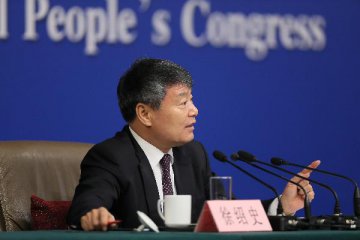
The debt-to-equity swap was rapidly popular across China in recent years. Central state-owned enterprises (SOEs), which are leading in the market, also participated in the debt-to-equity swap campaign. Following Aluminum Corporation of China and China State Shipbuilding Corporation Limited, China Railway Group Limited announced in a statement released on May 6 that it is mulling over debt-to-equity swap plan, and underlying asset will be part of equities of subsidiary that investors acquire during the debt-to-equity swap, which may result in major assets restructuring. The company suspended stock trading from May 7.
Since the State Council launched documents on lowering leverage ratio of enterprises and debt-to-equity swap plan for banks in October 2016, the market-based debt-to-equity swap plans started, while central SOEs were major participants try the plan.
Liu Xiangdong, deputy researcher from economic research department of China Center for International Economic Exchanges, said the reporter of Securities Daily that central SOE’s active participation in debt-to-equity swap is out of pressure from deleverage, aiming to lower debt risks and transfer risks to creditors through debt-to-equity swap. Without shifting out controlling stake, it will effectively improve capitals security and reduce market risks.
An analyst who declined to be named told the reporter that reducing high leverage of SOEs has become the priority among priorities this year. Asset securitization of SOEs will speed up significantly in the future. Market-based debt-to-equity swap is likely to become normality and a development mechanism. It will apply to iron and coal industries, which will play an important role in SOEs’ deleverage.
According to a research report previously released by Minsheng Securities, debt-to-equity swap has drawn much attention from the market since 2016. However, by 2018, there are more projects of debt-to-equity swap signed but fewer put into place. As for reasons, on the one hand, detailed policies about implementation of debt-to-equity swap are still not clear. On the other hand, after the supply-side structural reform, operation of upstream cyclical industries was improved and pressure from debts was relaxed, which made them less motivated to carry out the swap. It is unlikely that a great number of such projects will be put into place in a short term.
When speaking of the significance of central SOEs’ participation in debt-to-equity swap on the market and themselves, Liu viewed that central SOEs reform is an important part of SOEs reform. Under the requirement of deleverage, boosting debt-to-equity swap reform of central SOEs cane effectively lower their leverage ratio, reduce burdens of debt expenses and simplify their operation. As debt-to-equity is market-oriented, it is highly efficient and can optimize resource allocation.
Translated by Vanessa Chen




















Latest comments